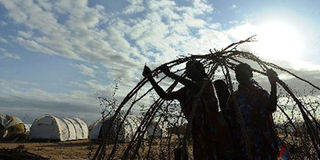Agency wants new refugee camp set up

Somali refugees build a makeshift shelter at the new Ifo-extension in Dadaab on July 31, 2011. UNHCR wants another camp created in Kenya saying an influx of displaced people from neighbouring countries have overstretched facilities August 4, 2012. FILE
The global refugee agency wants another camp created in Kenya saying an influx of displaced people from neighbouring countries have overstretched facilities.
United Nations High Commission for Refugees has suggested the camp be established some 35 kilometres from Kakuma refugee camp, which was formed in 1992 and surpassed the 100,000 refugees limit last month.
“Kakuma refugee camp has this week surpassed its capacity of 100,000 refugees. As of July 31, the camp population has reached 100,009 following a steady influx of new arrivals over the past two year," said a statement from UNHCR.
"In 2012 some 12,123 individuals have been registered in the camp, the majority having fled violence and conflict in South Sudan's Jonglei State and Sudan's South Kordofan. Significant numbers from Burundi, Ethiopia, Somalia, and the Democratic Republic of the Congo have also sought asylum this year."
The Kenya Government has, however, not reached an agreement with the UN body on where a new camp would be established.
Kenya has in the past insisted that another stable country should shelter the refugees saying the country was overburdened.
For instance in the case of Somalia, the government even suggested that refugees at Daadab be moved to areas that had been liberated from Al-Shabaab rule in the war torn country.
“UNHCR remains optimistic that discussions will be successful and that additional land will be made available before the end of the year,” UNHCR added.
An estimated US$16.7 million (Sh1.4 billion) would be required to set up the new camp.
UNHCR's head of the sub-office Guy Avognon noted that the influx is expected to continue into next year and cautioned it could cause conflict within Kenyan communities living around the refugee camp.
He said the threat of conflict in neighbouring countries, particularly Sudan and South Sudan, is expected to continue to drive asylum seekers toward Kenya for the remainder of the year and into 2013.
In Kakuma, he “expressed concern about possible tension between camp residents and members of the local community due to the limited availability of water and other resources in the area. The provision of life-saving assistance and important services is becoming increasingly difficult due to limited funding to cater for the growing population, particularly in the shelter, sanitation, education, and healthcare sectors.”
The sustained rate of new arrivals to the camp has already depleted all available land in the new settlement areas, and despite serious overcrowding in many parts of the camp.
And the Kakuma refugee camp cannot be extended further because new water sources have not been identified.
“Since the beginning of the year efforts to supply sufficient quantities of clean, safe drinking water have become a critical challenge with refugees now receiving less than the standard 20 litres of water per person per day,” said the UNHCR statement.




